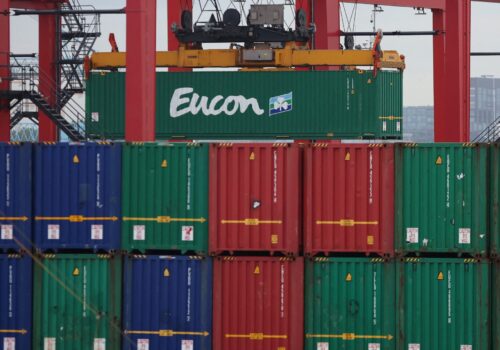Looking ahead to the next chapter of US-EU digital collaboration
This essay is part of the report “Transatlantic horizons: A collaborative US-EU policy agenda for 2025 and beyond,” which outlines an agenda for common action for the next US administration and European Commission.
The bottom line
In the past four years, during Ursula von der Leyen’s first term as European Commission president and Joe Biden’s time as US president, there has been a strong convergence across the Atlantic in the governmental approach to digital and technology-related issues. However, the transatlantic agenda for the coming years remains unclear and will depend on the impact of the debate over competitiveness now emerging in Europe and the outcome of the US election in November. There are opportunities for further collaboration, especially in addressing emerging technologies and the risks both sides face from bad actors in the digital sphere. Whether this will be an effort driven by the European Union (EU) or one in which the United States is an equal partner is not yet certain.
State of play
Von der Leyen entered office in late 2019 with a strong focus on digital policy. Despite the pressures of the COVID-19 pandemic and Russia’s full-scale invasion of Ukraine, the European Commission put forward a tsunami of legislation, most of which has now passed, including the Digital Markets Act, Digital Services Act (DSA), Data Governance Act, Data Act, Cyber Resilience Act, and the Artificial Intelligence Act. While there is a growing debate about the impact of such extensive regulation on European innovation, as discussed in former President of the European Central Bank Mario Draghi’s recent report on competitiveness, there are few indications of any back-tracking on these new laws.
In contrast, the Biden administration entered office without strong ambitions in this area, although the president had expressed some concerns about the impact of social media on the electorate. However, there was a big shift in the administration’s attitude toward artificial intelligence (AI) as that technology developed. Through a series of “blueprints,” voluntary guidelines, and executive orders, the Biden administration has largely adopted the EU’s risk-based approach to AI, at least in its assessment of the dangers and its objectives.
This convergence in tech policy cannot be divorced from the growing transatlantic alignment on China. The Biden administration has emphasized the need for greater oversight and restrictions on transfers of technology and data to that country. The 2023 suspension of US participation in the World Trade Organization’s digital trade efforts and the citing of national security considerations in limiting data flows to “countries of concern,” including China, seem to mark a turning away from the long-held US commitment to open data flows. Moreover, the Protecting Americans’ Data from Foreign Adversaries Act passed as part of a foreign aid package for Ukraine and Israel puts restrictions on data brokers that receive US personal data based on their foreign ownership.
In Europe, there has been a growing caution about Chinese equipment and investments in the communications and high-tech sectors, although the policy is often described as differentiating between trusted and untrusted vendors. Most recently, the EU has opened investigations into China’s subsidization of its electric vehicle (EV) battery and wind turbine industries. Although there are still differences, the last four years have seen a growing transatlantic consensus on the risks posed by China’s anti-competitive behavior and its impact on US and EU autonomy in key technologies.
The strategic imperative
The US-EU digital relationship is one of the strongest and most lucrative in the world—US tech companies earn more in Europe than anywhere else in the world. At the same time, EU rules affect those companies’ operations not only in the European market but often far beyond. The question for US and EU policymakers is how to create a more coherent transatlantic—and perhaps even global—digital marketplace, one where regulation and innovation incentives can be balanced. Can the United States and the EU find enough common ground to achieve that ambition? If they do not cooperate—and perhaps even adopt opposing policy approaches—will companies then face two distinct markets? In that circumstance, will the EU become even more focused on digital sovereignty and restrictive regulations while the United States becomes a relatively less-regulated space? Will companies be forced to choose whether to adhere to strict European regulations or forgo the profitable European market?
Looking ahead
Whether the United States and the EU will succeed in building greater cooperation on digital and tech issues will depend in large part on two factors. First, the EU is engaged in an internal discussion on how to enhance the bloc’s economic competitiveness. A key element of that should be to provide a more business-friendly environment across the economy while encouraging citizens, governments, and businesses to participate in the digital transition and provide the protections they expect. Competitiveness does not mean no regulation, but rather that compliance with the rules does not create prohibitive burdens, especially for innovative start-ups. Europe also needs to boost its digital engagement and provide its people with the skills needed to flourish in the digital economy. In short, will it be Estonia or France that emerges as the model for how Europe balances regulation and innovation? If Europe comes to believe that the only way it can enhance its competitiveness is by restricting certain markets to European companies, transatlantic cooperation will inevitably become more challenging.
Second, the future of US-EU collaboration will also depend on the outcome of the US presidential election. Although digital and tech policy has figured little in the race to date, there are some clear differences. Vice President Kamala Harris has been deeply engaged in the Biden administration’s approach to AI, and measures such as those in the Biden administration’s executive order on AI are likely to be reinforced in a Harris administration.
The path forward is murkier if former President Donald Trump returns to the White House. He has already said that he would withdraw the Biden administration executive order on AI, a move that would distance the United States from the Group of Seven and others who seek to constrain some uses of AI. While messages from the Trump campaign have been mixed when it comes to the large tech companies, the conservative manifesto Project 2025 has called for the end of the Federal Trade Commission and its anti-trust role, as well as removing environmental and other rules that the project’s authors believe have constrained the growth of technology companies. This position will be received with much skepticism, if not alarm, in Europe. US tech companies are already viewed in Europe as under-regulated, and a relaxation of current US rules is likely to lead Europe to respond by stepping up enforcement of its new digital rules even further. Even if a Trump administration does not roll back existing regulation, all indications are that it will resist any further constraints on tech companies, including measures such as labeling AI-generated content or restricting the distribution of fake videos. Such a stance is unlikely to provide a foundation for greater US-EU cooperation.
For much of the last four years, the EU has been a world leader when it comes to tech regulation, while the United States, in some areas, has not even had a policy in place. Some would argue that the EU’s focus on regulation has hampered corporate innovation and the opportunity for European tech superstar companies to develop. That may be, but in the absence of comparable US regulation, the EU has become the default arbiter of rules that govern the digital economy, including the global behavior of US companies. Unless the United States engages more actively—including putting forward concrete legislative and regulatory proposals—Europe is likely to continue to set the pace, especially on regulating AI and disinformation. And if the United States fails to enact guardrails in the digital sector and instead decides that the digital economy should continue to be lightly regulated, the EU is likely to respond by strengthening enforcement of its own rules, especially against US companies. Consistent and constructive US-EU regulatory engagement, therefore, is an essential component of a transatlantic digital marketplace.
Policy recommendations
The United States and the EU should focus on a few key areas to create a more coherent transatlantic digital marketplace. These do not represent the entire universe of existing digital policy. (One area omitted here is competition policy, which is governed by distinct legal processes in the United States and the EU.) It should also be noted that during the coming years, entirely new areas of digital and tech are likely to emerge as crucial in the transatlantic partnership. Thus, it is important that a mechanism exists that allows for continuous conversations about these matters. During 2021–24, the US-EU Trade and Technology Council (TTC) provided valuable opportunities for consultation and for aligning US and EU approaches. During the next US administration, a revamped TTC or similar mechanism should be available to ensure continued close communication across the Atlantic on these fast-moving issues.
Cybersecurity: During the past few years, the United States and Europe have experienced an increasing number of cyberattacks, although specific numbers are difficult to secure, given that not every victim reports an attack. In 2023, the cost of cybercrime was estimated at $11.5 trillion and is expected to be almost $15 trillion in 2024. Both China and Russia have been identified as facilitating—if not ordering—some of these attacks, demonstrating cyber’s growing role as a key area of hostile state action, in addition to the longtime involvement of criminal enterprises. Coordinating policy toward cyberattacks and developing greater cyber resilience should be a top priority for policymakers. The US-EU Cyber Dialogue has been important in facilitating dialogue about specific attacks and strategies for countering those efforts. Recently, it has also started to address the different US and EU regulatory measures aimed at creating resilience, both in critical infrastructure and in connected devices. Coordination between the United States and the EU will be essential not only in ensuring that consumers are safe but also in building the collaboration required to keep societies secure in the face of a growing onslaught by hostile actors. Some important steps have been taken, but the threat will evolve, and so must the response.
AI and emerging technologies: One of the biggest successes of the TTC was the convergence it inspired on the issue of AI. While the EU led with the AI Act, the Biden administration gradually moved from inaction to establishing voluntary guidelines and then to issuing Executive Order 14110 imposing rules on those seeking to do AI-related business with the US government. The commercialization of ChatGPT happened just as the AI Act was nearing completion, and a few provisions were hastily added in response, especially to ensure that generative AI was treated as high risk. While the United States will probably struggle to pass comprehensive AI legislation, some US states have started to fill the domestic breach by passing their own AI laws. For example, the Colorado law passed in May imposes similar restrictions and responsibilities on AI developers as does the EU AI Act. But there is no denying that AI is a rapidly evolving technology that will require ongoing government review and regulation. Indeed, Microsoft president Brad Smith recently called for more government regulation to combat “abusive AI-generated content.” During the next five years, as AI is integrated into people’s daily lives and as more uses (good and bad) develop, US-EU cooperation in facilitating the productive use of AI while constraining its harmful uses will be essential. As a first step, transatlantic conversations about the implementation of rules for the EU AI Act will determine how compatible US and EU rules will be in practice.
Quantum computing: AI is not the only technology that requires cooperation across the Atlantic. Quantum computing has already been identified by the TTC as the next emerging technology worthy of focus. Given the enhanced power and computing speed that quantum would provide for researchers and AI developers and deployers, for example, there is definite value in the technology. But it also offers those same capabilities to those seeking to hack into critical infrastructure systems or financial or healthcare institutions. Thus, ensuring that quantum capabilities are securely held should be a top transatlantic priority for ongoing tech discussions. On September 5, the US Commerce Department issued rules establishing export controls on certain elements of quantum computing. Although some EU member states were identified as eligible for exemptions from these restrictions, the EU as a whole is not. Discussions on quantum computing are already underway in the TTC, but they are now more urgent so that the United States and the EU can maintain a united front.
Data governance: This topic should also be much higher on the list of US-EU priorities than it has been in the past. To date, this discussion has focused on ensuring the transfer of EU personal data to the United States in the commercial setting in a manner compatible with the EU General Data Protection Regulation. But the recent US decision to begin limiting how US data can be shared and the continuing US-EU negotiation on law enforcement access to electronic evidence make this issue one that is ripe for intensive US-EU discussions, especially as the new Commission will present a European Data Union Strategy. The United States and the EU urgently need to build more consensus in the movement and governance of data.
Online safety and combating disinformation: In the wake of the European Parliament elections—and with the US elections looming—increased attention should be paid to the threat of intentional disinformation, as well as the harms done by online targeting of individuals. AI has escalated this threat, as demonstrated by faked audio recordings released during the Slovak election campaign and the AI-generated fake video of Harris featured on X. While the EU has the DSA and other legislation to rein in illegal and harmful content, the United States has resisted such measures, citing free-speech protections. Once the US elections are over and the impact of online and offline disinformation can be assessed, this should become an important area of collaboration between the two democracies. But there is also great potential for transatlantic tensions in this area, especially since European and US ideas—and laws—on free and prohibited speech can vary. A Trump administration may well view EU attempts at content moderation under the DSA as efforts to censor free speech. Recent communications between then-European Commissioner Thierry Breton and X owner Elon Musk demonstrate the potential for misunderstanding, especially if the focus becomes harmful, rather than illegal, speech. In the future, close consultation will be essential if the US-EU partnership is to be effective in managing real disinformation.
Frances G. Burwell is a distinguished fellow at the Atlantic Council’s Europe Center and a senior director at McLarty Associates.
read more essays

The Europe Center promotes leadership, strategies, and analysis to ensure a strong, ambitious, and forward-looking transatlantic relationship.
Image: US Secretary of State Antony Blinken takes pictures of the press next to US Trade Representative Katherine Tai, US Secretary of Commerce Gina Raimondo, European Commission Executive Vice-President Margrethe Vestager, European Commission Executive Vice-President Valdis Dombrovskis, and European Commissioner for Internal Market Thierry Breton as they pose for a family photo on the day of the US-EU Trade and Technology Council in Leuven, Belgium April 5, 2024. REUTERS/Johanna Geron/Pool.


